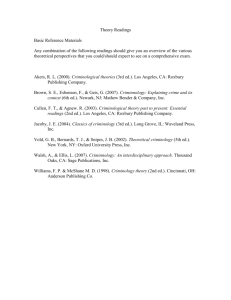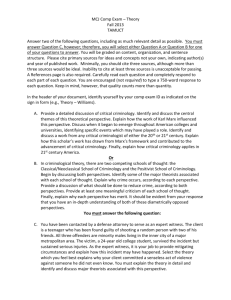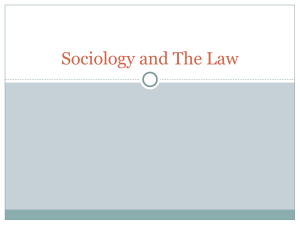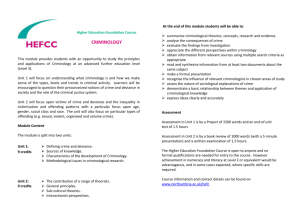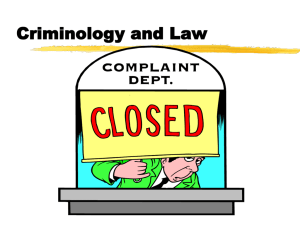Criminology 352 Environmental Criminology: Theory and Practice School of Criminology Simon Fraser University
advertisement
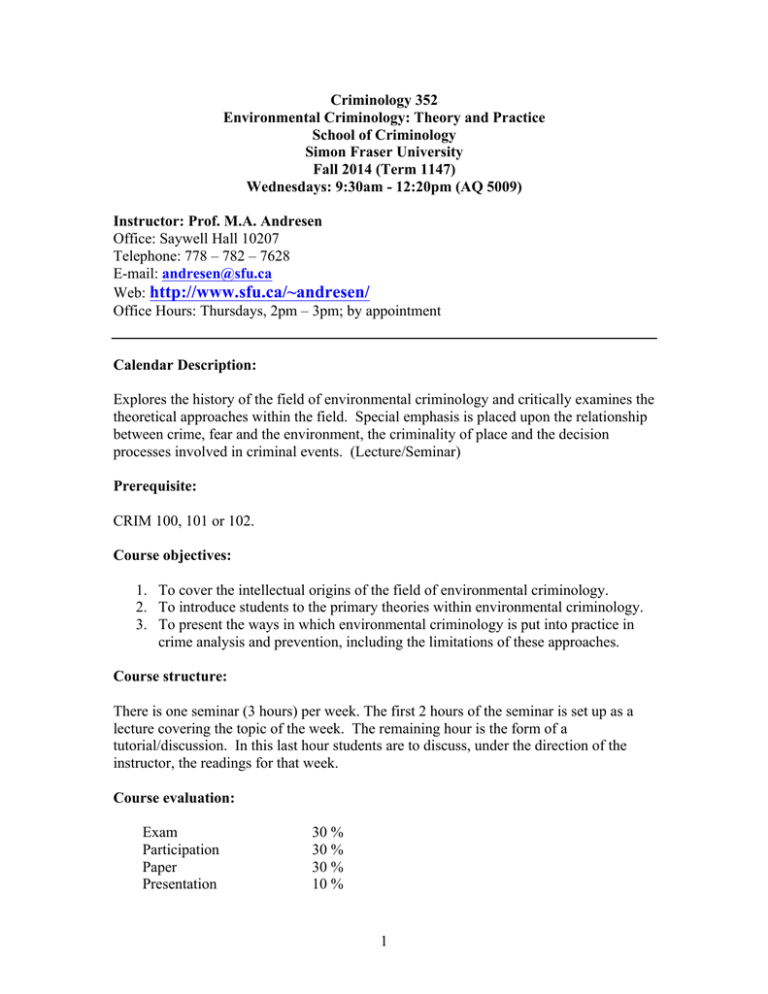
Criminology 352 Environmental Criminology: Theory and Practice School of Criminology Simon Fraser University Fall 2014 (Term 1147) Wednesdays: 9:30am - 12:20pm (AQ 5009) Instructor: Prof. M.A. Andresen Office: Saywell Hall 10207 Telephone: 778 – 782 – 7628 E-mail: andresen@sfu.ca Web: http://www.sfu.ca/~andresen/ Office Hours: Thursdays, 2pm – 3pm; by appointment Calendar Description: Explores the history of the field of environmental criminology and critically examines the theoretical approaches within the field. Special emphasis is placed upon the relationship between crime, fear and the environment, the criminality of place and the decision processes involved in criminal events. (Lecture/Seminar) Prerequisite: CRIM 100, 101 or 102. Course objectives: 1. To cover the intellectual origins of the field of environmental criminology. 2. To introduce students to the primary theories within environmental criminology. 3. To present the ways in which environmental criminology is put into practice in crime analysis and prevention, including the limitations of these approaches. Course structure: There is one seminar (3 hours) per week. The first 2 hours of the seminar is set up as a lecture covering the topic of the week. The remaining hour is the form of a tutorial/discussion. In this last hour students are to discuss, under the direction of the instructor, the readings for that week. Course evaluation: Exam Participation Paper Presentation 30 % 30 % 30 % 10 % 1 Textbook: Andresen, M.A. (2014). Environmental Criminology: Evolution, Theory, and Practice. New York, NY: Routledge. Hereafter referred to as EC. Andresen, M.A., P.J. Brantingham, and J.B. Kinney [eds.] (2010). Classics in Environmental Criminology. Co-published: Burnaby, BC, SFU Publications and Boca Raton, FL, Taylor & Francis. Hereafter referred to as CEC. There are also some supplementary readings, mostly available through Canvas. You are responsible to download, photocopy, or borrow these readings from the library. Lecture topics, schedule, and readings: Lecture 1. Introduction to the course • Week 1 (03 September) • EC, Chapter 1; CEC, Chapters 1 and 2 Lecture 2. Social disorganization theory • Week 2 (10 September) • EC, Chapter 2; CEC, Chapters 4 and 5 Lecture 3. Routine activity theory • Week 3 (17 September) • EC, Chapter 3; CEC, Chapters 8 and 9 Lecture 4. Geometric theory of crime • Week 4 (24 September) • EC, Chapter 4; CEC, Chapters 10, 11, and 12 Lecture 5. Rational choice theory • Week 5 (01 October) • EC, Chapter 5; CEC, Chapters 13, 14, and 15 Lecture 6. Bringing it all together: crime pattern theory and crime prevention • Week 6 (08 October) • EC, Chapters 6 and 7; CEC, Chapter 16, 17, 20, and 21 Lecture 7. Hot spots in space and time • Week 7 (15 October) • EC, Chapters 10 and 11 Lecture 8. The crime drop and geographic profiling • Week 8 (22 October) • EC, Chapters 12 and 13 2 Lecture 9. (Near-) repeat victimization and crime and place • Week 9 (29 October) • EC, Chapters 14 and 15 Examination • Week 10 (05 November 2014) Class Presentations • Weeks 11, 12, and 13 (12 November, 19 November, 26 November) The Paper The paper you are to write, and present, for this course shall be approximately 2500 words. Any significant deviation in length, both too long and too short, may be cause for a reduced grade. You are to obtain, using the library resources, three (3) related book chapters and/or journal articles (NO “TEXTBOOK” CHAPTERS) that are in the field of environmental criminology, or a field that relates to environmental criminology; geography of crime and urban planning are a couple of examples. Please feel free to contact me if you are unsure of your topic. None of your choices may be from the course reading list, required or recommended. For each paper/book chapter, you are to provide the thesis, main points, conclusion, and your assessment of the research. Think of using 750 words for each paper/book chapter. Then use the remaining 250 words to tell me what you have learned from your paper. In other words, synthesize everything. These are, however, just guidelines for length. How you choose to write your paper is up to you. You may “stack” the 3 reviews in a format similar to an annotated bibliography. Or you may treat the 3 articles and/or book chapters as a single entity and write about that entity referring to your chosen articles and/or book chapters. If you are interested in a particular aspect of environmental criminology that you would like to explore further, you may also write a “standard” research paper. The paper is due on the last day of class: 26 November 2014. General Outline for Class Presentation Your presentation will take up 10 – 12 minutes: approximately 8 - 10 minutes of your talking, and 2 – 4 minutes of fielding questions from your classmates. We will be on a tight schedule so it is important that presentations do not go over this time. You will be choosing your presentation date (from the 3 available weeks) so once 3 your date is set, it is set. If you wish to change your presentation date you must find someone to switch with. You are to present on one article/paper/chapter that is in your course paper, or the common theme within the 3 pieces of work you are writing about—discussing 3 separate ideas will be to time consuming. Consequently, you will want to focus on how the article/paper/chapter is relevant to the course (briefly), what theoretical point of departure it has, and the contribution of the article/paper/chapter. This contribution may be extending theory, the testing of theory, policy implications, or some combination of all three. Your goal, in 10 – 12 minutes, is to teach your classmates a little something about the course material that was not covered in class. General Outline for Course Paper For each article/paper/chapter provide the following: 1. 2. 3. 4. Thesis of the work The Main Points The Conclusions of the Authors Your Assessment of the Work With three papers to review, this should be approximately 750 words for each paper. Lastly, provide 250 or so words stating what you learned from reading these thee papers. The total is 2500 words. 4 ATTENTION STUDENTS WITH A DISABILITY: Please contact the Centre for Students with Disabilities, (MBC 1250 or Phone 778-782-3112) if you need or require assistance, not your individual instructors. N.B.: Students are reminded that attendance in the first week of classes is important. However, there are no tutorials in the first week. Assignments not submitted to the Professor/T.A. during class/office hours must be placed in the security box at the School of Criminology General Office (Saywell Hall). The box is emptied Monday to Friday at 8:30 a.m. and 3:30 p.m. only and the contents are date stamped accordingly. No other department’s date stamp will apply (e.g. Library/Campus Security) and the School of Criminology is not responsible for assignments submitted any other way (e.g. slid under office doors). E-mail policy: The School of Criminology STRONGLY DISCOURAGES the use of email in lieu of office hour visits. Criminology advises its instructional staff that they are NOT required to respond to student e-mails and that students wishing to confer with them should do so in person during scheduled meeting times. The University does NOT accept assignments by fax. The University has formal policies regarding intellectual dishonesty and grade appeals which may be obtained from the General Office of the School of Criminology. UNIVERSITY POLICY FORBIDS FINAL EXAMINATIONS WHILE CLASSES ARE STILL IN SESSION. 5
